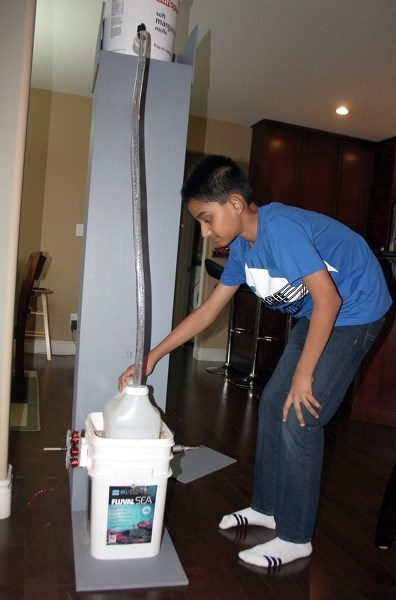After sweeping the competition at the Regional Science Fair April 12 at NAIT, R.F. Staples Grade 8 student Siddhant Gautam earned himself a trip to Windsor, Ont., next month.
His third try was the charm as his hydroelectric generator project earned him a trip to the National Science Fair May 10-17 — a goal he’s been working towards since he was in Grade 6.
“I’m really happy I get to compete in nationals,” he said. “This is my third year trying and I finally managed to get in. I’m pretty excited about it.”
Gautam’s projects for the last two years dealt with cleaning spilled oil out of water, a project with obvious big-picture benefits in the wake of high-profile oil spills over the past couple years.
This year he turned his attention to a topic that could have a great impact closer to home — how to effectively heat sidewalks to melt off the snow and ice in wintertime.
“I think heated sidewalks are a great idea. They’re beneficial to people who have to maybe walk to school or walk to bus and train stations,” he said. “I was thinking of an economical and eco-friendly way to power them.”
Some municipalities around the world use geothermal energy or even waste heat from factories to heat sidewalks, but that’s not necessarily feasible here. One possibly solution is to find a hyper-local power supply — in this case, water running down storm drains.
Gautam built his own hydroelectric generator to determine how much power could be generated. He began with the hypothesis that he could generate about 4.5 volts, based on research he did online.
The next step was to build a generator, which again proved the third try’s a charm.
“The first one didn’t make any electricity. The second one made 0.2 volts and the third one makes about 0.5 or 0.6 volts,” he said.
Using a commercial generator might have yielded a higher voltage, he said, but for him the goal was more about learning how a generator works by building his own.
“I tried to make most of the stuff homemade, since there’s definitely more to learn than if I had just bought a generator,” he said.
The judges at both the local and regional competitions took notice of Gautam’s hard work. At the local level he took first prize for physical sciences as well as the special award for electricity and magnetism.
At the regional fair, he won gold in the junior category, an honourable mention from the Institute of Electrical and Electronics Engineers, the E.H. Gowan physics award and the junior-category award from the Association of Professional Engineers and Geoscientists of Alberta.
The awards are nice, of course, but aren’t the reason Gautam takes part in the science fair.
“Mostly it’s about the learning,” he said. “In school right now we’re not learning about physics or things like this, so it’s cool to understand how things work that are really common.”



